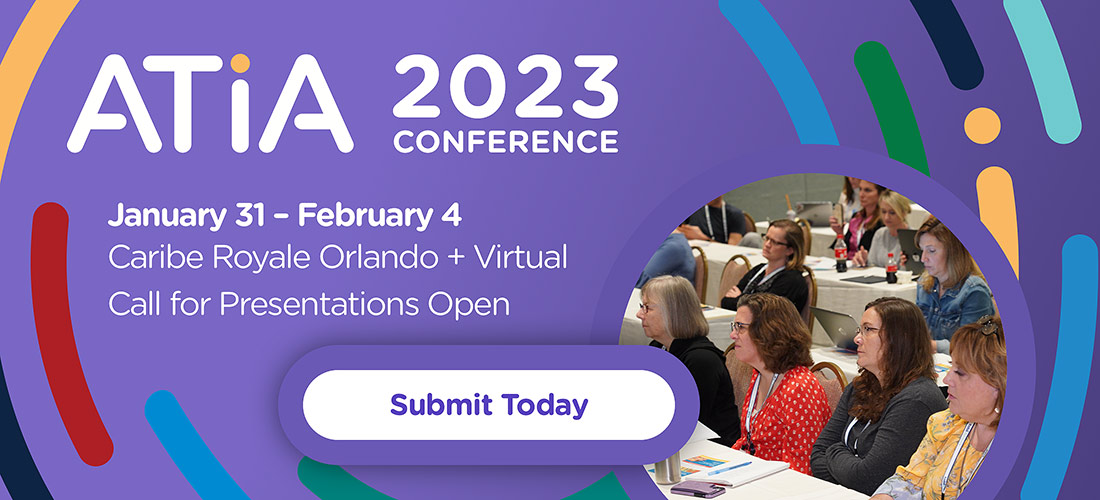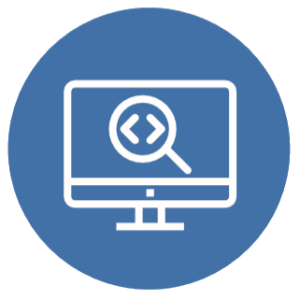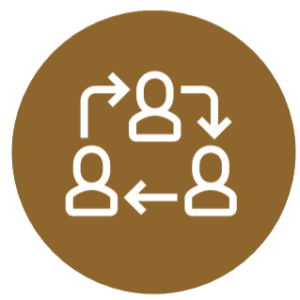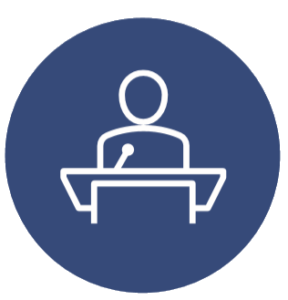ATIA 2023 Session Strands
The ATIA 2023 education program is planned around eight Strands, to provide a balanced approach to explore the most important questions and issues facing AT professionals today, allowing you to focus on a specific area of interest or need.
The Strands are:
AT for Physical Access and Participation
William E. Janes, OTD, MSCI, OTR/L; Assistant Professor, Department of Occupational Therapy, University of Missouri; Representing Technology Special Interest Section, American Occupational Therapy Association (AOTA)
Judith Schoonover, MEd, OTR/L, ATP, FAOTA, AT Consultant; Representing Early Intervention & School Special Interest Section, American Occupational Therapy Association (AOTA)
Therese Willkomm, PhD, Director of Assistive Technology in New Hampshire, Institute on Disability at the University of New Hampshire (UNH). Representing Rehabilitation Engineering and Assistive Technology Society of North America (RESNA).
Sessions focus on improving function, access, and meaningful participation by individuals with disabilities or functional limitations through the use of a continuum of assistive technologies including those acquired commercially off the shelf, modified, or customized, as well as address barriers related to aging in environments and communities such as school, home, work, recreation, and general public access.
Sessions in this strand will focus on emerging and existing technologies or systems for: Alternate keyboard/mouse, eye gaze, head pointers, scanning, switches, innovative text entry, environmental control units (ECUs), mobile devices and apps, mounting devices, functional seating and mobility, home modification, activities of daily living, adaptive recreation and sports, and improved public access.
Topics in this strand may be of special interest to occupational therapists, physical therapists, speech-language pathologists, special educators, engineers, assistive technology professionals, transition coordinators, independent living specialists, Makers, consumers, as well as others who support individuals with disabilities and functional limitations that may impact access, participation, productivity, and achievement.
Topics include but are not limited to:
- Accessible toys, play, and playgrounds
- Adaptive recreation and disabled sports technologies
- Aging in place
- Community access technologies
- Computer access technologies
- Customized and 3-D printed solutions
- Employment access
- Environment access
- Ergonomics
- Functional seating and positioning
- Home access technologies
- Independent living
- Instrumental Activities of Daily Living (IADLs)
- Leisure
- Maker contributions to AT
- Rehabilitation
- School/education environments
- Transition to environment/community
Contact the AT for Physical Access and Participation Team at ATPAPStrand@atia.org.
Augmentative and Alternative Communication
Amy Goldman, President, USSAAC
Angela Standridge, Director, Texas Technology Access Program; Representing ASHA AAC SIG 12
Carole Zangari, Professor & Executive Director of NSU CARD Satellite, Nova Southeastern University
Children and adults with complex communication needs (CCN) due to developmental or acquired disabilities may benefit from augmentative and alternative communication (AAC) devices and services. Sessions in this strand focus on the ways in which existing and emerging technologies, tools, and strategies are used to enhance communication, language, literacy, and independence across the lifespan. All skill levels are welcome; submissions with intermediate or advanced content are strongly encouraged.
Topics include but are not limited to:
- AAC assessment approaches, models, tools, and outcomes
- Culturally responsive practices
- Development and use of visual supports
- Using AAC to build language and interaction
- Effective AAC intervention strategies
- Family supports for AAC
- Funding for AAC devices and services
- Implementation issues, such as generalization to real-world settings, teaming, and collaboration
- Interprofessional practices
- Literacy supports for people who use AAC
- Partner training and support
- Pre-service training and professional development in AAC
- Public policy issues that impact AAC
- Service delivery models
- Speech generating device (SGD), mobile device, AAC app, and interface design, features, and functionality
- Supports for high-quality AAC services in educational, healthcare, and community settings
- Technologies for teaching AAC skills
- Telepractice
- Vocabulary selection, development, and teaching
Education & Learning: Early Intervention – 12/Higher Education
Kelly Fonner, Assistive/Educational Technology Consultant & Special Educator
Luis Pérez, Ph. D., Technical Assistance Specialist, CAST
Carolyn P. Phillips, Co-Director of the Center for Inclusive Design & Innovation in the College of Design at Georgia Tech; Director and Principal Investigator of Tools for Life, Georgia’s AT Act Program; Representing AccessText Network
Submissions in this strand should focus on the effective implementation of assistive technology with students in early childhood, K-12 educational programs, higher education settings, including university/community colleges and trade schools. Topics in this strand typically include the implementation of assistive technology, accessible educational materials, and other inclusive technologies within face-to-face, remote, hybrid, and homeschooling environments.
Presentation proposals should be submitted from AT professionals, educators, parents, disability student service providers (DSSP), and/or support staff working with students who have learning disabilities, dyslexia, intellectual disabilities, autism, and/or multiple disabilities (sessions for students with vision and/or hearing impairments should be submitted to the Sensory Strand). Students and pre-service teachers are especially welcome as part of the presentation team.
Submissions involving assistive technology implementation processes, including agency-wide integration strategies are encouraged. This strand will highlight strategies and case studies that have been effective in improving retention, self-determination and graduation rates for students.
Submission of multiple products or systems are preferred over single-product-related presentations. Product demonstrations will be assigned as a vendor session. It is imperative, since ATIA is an assistive technology conference, that your presentation addresses the utilization of assistive technology within Early Intervention-K-12 or postsecondary environments. Sessions that do not include assistive technology will not be considered.
Topics include but are not limited to:
- AT accommodation best practices
- Technology tools and strategies to support developmentally appropriate practice in early childhood
- Assistive technology tools and strategies for reading, writing, and research
- Accommodating students in STEAM (science, technology, engineering, arts, and math)-related classes via Assistive technology tools and strategies
- Accommodating student accessibility in E-learning environments
- Accommodating veterans in higher education
- Supporting students with AT in testing environments
- Accessible educational materials and related technologies (AEM) with students
- Establishing a successful accessible media program
- Differentiated instruction and personalized learning through technology-supported accommodations
- Technology supports for executive function, self-regulation, and/or self-monitoring of tasks in educational settings
- Campus/District-wide assistive technology deployment and training/technical assistance
- Effective transition initiatives that include technology planning in situations of high school to post-secondary, vocational rehabilitation in college to workplace transition, and/or school to school.
Contact the Education/Learning Team at Education-LearningStrand@atia.org if you have any questions about this strand.
Mainstream & Web Accessible Technologies
Supporting Partner:
Rob Carr, CPACC, Strategic Accessibility Coordinator at WebAIM
Mike Marotta, ATP – AT Specialist; President, Inclusive Technology Solutions, LLC; ISTE Inclusive Learning Network’s 2017 Outstanding Educator Award Recipient
Sessions focus on the design and development of accessible technology as it relates to hardware, software, websites, mobile applications, proprietary applications, content, and documents. This includes the application of the inclusive features and functions of mainstream technologies that lend themselves for use by persons with disabilities or those working with persons with disabilities.
Topics in this strand may be of interest to developers, designers, testers, content creators and others involved in the design and development life cycle; managers and executives who support the implementation of accessibility and accessible/assistive technology; and, users with disabilities and the direct service providers working to implement inclusive technology solutions.
Topics include but are not limited to:
- Standards, policies, and best practices related to the design and development of accessible web and software tools and/or assistive technology solutions (including Web Content Accessibility Guidelines, Section 508 of the Rehabilitation Act, etc.)
- Mobile and other accessible technology implementations (Chrome OS, iOS, Android, Windows)
- Multimedia accessibility considerations and innovations (including standards and best practices in transcription, captioning, audio description and accessible multimedia players)
- Applications of commonly used operating system tools (built-in features along with customizations)
- Building and sustaining accessibility programs through policy, practice and governance
- Issues and challenges related to accessibility in web and software design, planning or implementation
- Testing and tools related to accessibility
- Interoperability between information technology and assistive technology
- Digital/technology inclusion initiatives
- Accessible Web applications (including web 2.0, web services, extensions, etc.)
- Portable and wearables (smart watches, Amazon Echo, VR headsets)
- Accessible applications of Virtual Reality (VR), Augmented Reality (AR) and Mixed Reality (MR)
Contact the Mainstream & Web Accessible Technologies Team at MainstreamWebAccessTechStrand@atia.org.
Transition and Workplace Accessibility
Teresa Goddard, Lead Consultant, Job Accommodation Network (JAN)
The Transition and Workplace Accessibility Strand focuses on technological and situation-based strategies for transitioning students and entry-level professionals to employment as well as accommodations for employees an applicant at other levels such as mid-career, returning, and late-career. Transitioning from secondary and post-secondary education to work often requires the successful use of assistive technologies to maximize access to career exploration experiences such as internships, cooperatives, and apprenticeships. Transitioning also requires an understanding of employer-based accommodation processes and technologies. Situation-based strategies matched to these processes and technologies, including innovative employment models, enable and empower young people with disabilities to not only find employment opportunities, but also to sustain employment for the long term. Similarly, applicants and employees with disabilities may benefit from various assistive technologies, strategies, and supports throughout the employment life cycle.
Presentation proposals should be submitted from transition coordinators, transition specialists, transition teachers, speech therapists, physical therapists, occupational therapists, vocational rehabilitation counselors, rehabilitation engineers, educators, AT specialists, job coaches, reasonable accommodation coordinators and/or support staff responsible for preparing transitioning students or entry-level professionals with disabilities. Proposals from talent acquisition staff and employer-based teams working to build and sustain employer talent pipelines are also welcome. Presentations should emphasize the successful use of assistive and employer-based technologies, innovative employment preparation models, and/or case studies for transitioning students and entry-level professionals, or employees and applicants with disabilities at various employment stages.
Topics include, but are not limited to:
- Strategies for acquiring and using assistive technologies for successfully transitioning students and entry-level professionals to employment
- Strategies for accessing mainstream employer-based workplace technologies
- Access-for-all or ease-of-use technologies to reduce barriers to employment for transitioning individuals
- Strategies for using assistive technology as a method to expand career options
- Case studies of innovative employment preparation models
- Processes for using assistive technology as a workplace accommodation
Contact the Transition and Workplace Accessibility Team at TransitionWorkplaceStrand@atia.org.
Vision & Hearing Technologies
Rachael Sessler Trinkowsky, Ph.D., CRC, CATIS, Technology Training and Vocational Coordinator, Lighthouse for the Blind of the Palm Beaches; Representing ACVREP
Carmelina Hollingsworth, Project Director, Resource Materials and Technology Center: Deaf/Hard of Hearing (RMTC-D/HH)
Sessions in this strand focus on assistive technology for individuals who are blind or have low vision, deaf, hard of hearing, or deaf-blind. Presentations are related to issues that impact the use of assistive technology in independent living, educational, avocational, and employment settings. Submissions should be considered by teachers, related service providers, SLPs, AT specialists, and other support staff who work with people who have sensory loss.
Topics include but are not limited to:
- Using AEM for learners with sensory loss
- Using AT for reading and writing for persons with sensory loss
- Implementing UDL with AT for learners with sensory loss
- Personal and assistive hearing technology
- Refreshable braille displays
- Braille translation software, braille embossing, and tactile imaging solutions
- Remote communication services for deaf/hard of hearing
- Digital talking books, E-books readers (apps and dedicated devices), DAISY, ePub and other digital book formats
- Accessible tablets, cell phones, and apps
- Optical character recognition (OCR) solutions (dedicated devices, computer-based systems, apps for smartphones and tablets)
- Screen reading software, screen magnification software, menu-driven accessible software, as well as other accessible software solutions for individuals who are blind or who have low vision
- Low vision devices
- Speech-to-text services and voice recognition software
- Assistive Communication Technology (videophone, text phone, alerting device)
- Web and media accessibility
- GPS and other wayfinding systems (dedicated devices and apps)
- Accessible medical & health monitoring devices)
- Emerging technologies for people with sensory loss
- Captioning Tools and Services
Contact the Vision & Hearing Technologies Team at VisionandHearingTechStrand@atia.org.
Leadership
David Banes, Director, David Banes Access and Inclusion Services UK
Cynthia Curry, Director of Technical Assistance, CAST
Leadership develops in many ways whether the leader, as an individual or organization emerges as one who inspires others or is assigned by administration. In today’s rapidly changing world, leaders face many challenges such as moving policy to practice, providing equitable services, attending to accountability measures, meeting the demands of new technologies and digital learning materials, addressing learner variability and providing professional development. Leaders at all levels are meeting these challenges with new and innovative approaches so that those who need AT are actively participating and making progress in their academic, employment and life goals.
Topics include but are not limited to:
- Leadership Principles and Sustaining Practice such as
- Strategic approaches to addressing needs
- Developing improvement plans, using data, and assessing impact
- Thought leadership
- Using research-based methods of systems change
Professional learning best practices such as:
- Implementing innovative approaches (e.g., online learning opportunities, video conferencing strategies, maker movements, job-embedded professional learning, communities of practice)
- Developing professional learning partnerships and leveraging funds
- Meeting legal mandates, moving from policy to practice to impact achievement of educational, vocational and life goals
- Leveraging funds and providing service delivery that is cost-effective and flexible
- Addressing rapid technology innovation impacting on both products and providers
- Integrating provision of accessible digital content into service delivery
- Disseminating information by multiple methods and sharing of resources
- Using strategies that ignite and sustain AT services (e.g., marketing, branding, social media)
- Promoting cross-departmental and family engagement in the integration of AT in PK-12, postsecondary, and employment settings.
- Reviewing international outcomes that inform AT practices
- Focusing on the provision of AT in the context of the UD and UDL framework
- Demonstrating innovative service delivery models informed by shifting to remote and hybrid learning during COVID-19
Contact the Leadership Team at LeadershipStrand@atia.org.
Research
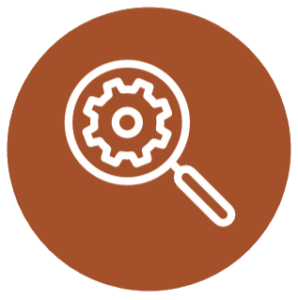 Anya Evmenova, Ph.D., Associate Professor in the College of Education and Human Development, George Mason University; Representing the Assistive Technology Outcomes and Benefits research journal (ATOB)
Anya Evmenova, Ph.D., Associate Professor in the College of Education and Human Development, George Mason University; Representing the Assistive Technology Outcomes and Benefits research journal (ATOB)
Lori Geist, , Ph.D., CCC-SLP, Assistant Professor at the Center for Literacy & Disability Studies, Department of Allied Health Sciences, School of Medicine, University of North Carolina at Chapel Hill; Representing the ATIA Research Committee
Across all strands, research sessions are intended to foster communication among stakeholders about research in the field of AT, including manufacturers, sellers, practitioners, policymakers, consumers with disabilities, family members, and academic researchers. In return, this will help stakeholders advocate for data-driven effective AT devices and services. Presenters in this strand are encouraged to showcase the evidence regarding effective AT use as well as emphasize the practical implications of studies to bridge between research and practice.
All research methods are invited, including exploratory, descriptive, experimental, qualitative, mixed methods, and systematic review. Reviewers will be looking for a clear presentation of the key aspects of your study. All submissions should include a clear purpose statement and/or hypothesis, a description of your research design and methods, your results (or preliminary analysis), and a discussion of implications. Other sections of the submission will depend on what is most applicable to the research approach you used.
Aligned with the major submission categories within the ATIA journal Assistive Technology Outcomes and Benefits (ATOB), voices from academia, industry, and the field are welcome. Presentations may focus on (but are not limited to):
- Studies of consumer performance, perceptions, attitudes, use and/or abandonment related to assistive technology. As applicable, describe the population addressed, the nature of your sample, and the instrument or survey you used.
- Experimental examination of assistive technology assessment, intervention, and service delivery. Be sure to describe the intervention being studied.
- Effectiveness and impact of specific assistive technology approaches, such as service delivery models, AT devices, training, etc. Describe the approach(es) being studied and the methods used to determine the effectiveness.
- Product development research: Include a description of the innovation, the design process, usability testing, target population(s), and how it is being implemented.
Presenters within the research strand are encouraged to consider expanding their presentation and submitting their work to the ATOB journal which has an annual Call for Manuscripts every spring.
Contact the Research Team at ResearchStrand@atia.org.

